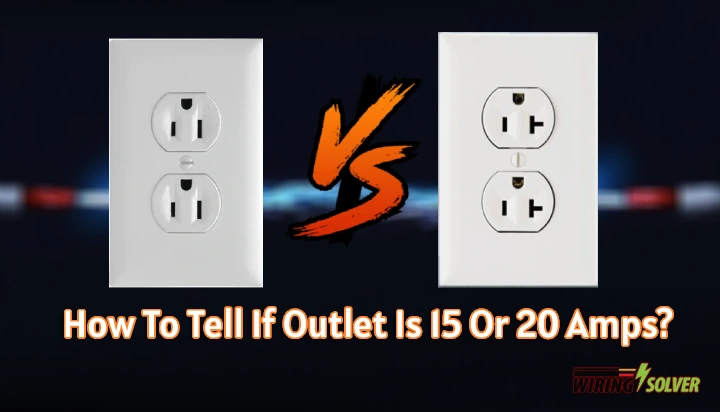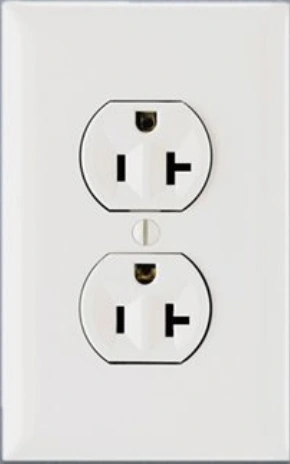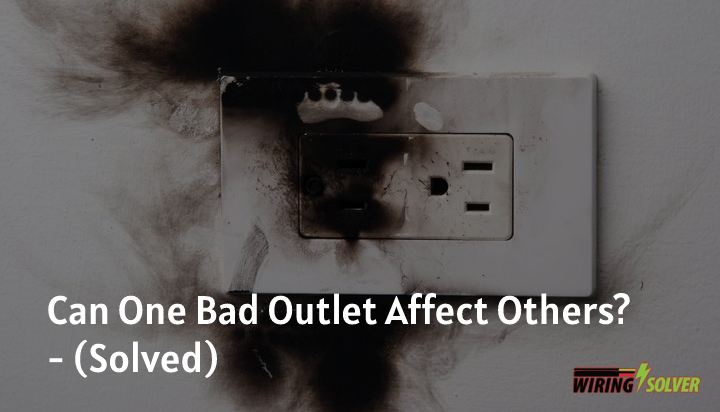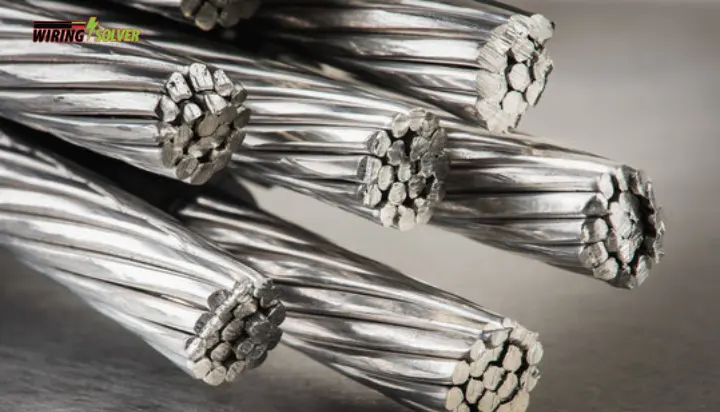The amperage determines the amount of electrical current that can safely flow through it. If you plug in an appliance that requires more current than the outlet can handle, it could result in a fire hazard.
Two common types of outlets are 15 and 20 amps. It is important to know which one you have before plugging in any appliances. You can differentiate them by their physical appearance.
In this article, how to tell if an outlet is 15 or 20 amps will be explained, so you can ensure the safety of your home and its electrical system.

How to Tell If Outlet Is 15 Or 20 Amps?
If it has 2 slots (Hot + Neutral) vertically with U-shape ground, it’s a 15-amp outlet.
However, the 20-amp outlet holds 1 vertical (Hot) and T-shape (Neutral) prongs with ground connection. And that’s the easiest way to recognize them.
You might ask ‘how do I know what AMP my outlet is?’ but the answer relies on some electrical points. And these are:
- The slot that is wider, consider it as ‘Neutral’ pin. Most of the time, it is connected with white color wire to the screw terminal of the outlet.
- The slot that is tiny, consider it as ‘Hot’ pin. It is connected with the black and red wire to the brass shade screw.
- The half-circular hole is the ‘Ground’ pin. It is connected with green/ green with yellow stripe wire to the green screw.
Now that you know each type of slot or prong identification, it should be clear whether do 20 amp outlets look different or the same as the 15-amp one. Let’s get into that!
What Does A 20 Amp Plug Look Like?

The 20-amp plug or outlet has a different outlook due to the ‘T’ shape slot on the wider side, which is Neutral.
And then, it holds a straight yet narrower slot side by side attached, which is Hot pin. Under these 2 slots, the semicircular slot is the ground line.
This outlet is one of the best options for high-powered tools use that offer a stable and strong power source for appliances. And, it can be used with both 15 and 20-amps devices or machines.
Similarly, some find the two different voltages of outlets hard to locate and for that, you should look at 110v vs 220v outlets.
The Importance of Proper Outlet and Appliance Matching
It is important to delve into the reasons why it is important to match the amperage of an outlet with the electrical requirements of an appliance. Some potential points to cover under this subheading might include:
- Avoiding Overloading Outlets: If you plug an appliance that requires more current than an outlet can handle, it could overheat and cause a fire hazard.
- Protecting Appliances: Plugging an appliance into an outlet with too little amperage could result in poor performance or damage to the appliance over time.
- Ensuring Safe Electrical System Operation: Proper outlet and appliance matching helps to prevent overloading of the electrical circuit and helps to ensure the safety and efficiency of the overall electrical system.
- Avoiding Code Violations: Some local codes require that appliances be plugged into outlets with a specific amperage, so proper matching is important for compliance.
You may also look at “the number of 15 amp outlets on a 20 amp circuit to use”.
What are Some Safety Tips for Working with Electrical Outlets?
Here are some safety tips for working with electrical outlets:
- Turn off the power: Always turn off the power to the circuit before working with electrical outlets to prevent electrical shock or injury.
- Use proper tools: Use the appropriate tools and equipment when working with electrical outlets, such as rubber-soled shoes, non-conductive tools, and insulated electrical tape.
- Don’t touch live wires: Never touch live wires with your bare hands, as this can result in electrical shock or injury.
- Avoid overloading: Don’t overload outlets by plugging in multiple high-wattage appliances. This can cause a fire hazard.
- Keep outlets dry: Avoid using electrical outlets near water sources, such as sinks or bathtubs, to prevent electrical shock.
- Avoid DIY repairs: If you are not familiar with electrical systems, it is best to hire a professional electrician to perform repairs or installations.
- Use GFCI outlets in damp locations: Use ground fault circuit interrupter (GFCI) outlets in damp locations, such as bathrooms or kitchens, to prevent electrical shock.
By following these safety tips, you can ensure the safe and efficient operation of your electrical system and reduce the risk of electrical shock or injury.
Frequently Asked Questions (FAQs)
1. How many outlets on a 15-amp circuit?
Based on National Electrical Code, it is stated, 1 outlet can be used on 1.5 amps of the circuit. Yet, the circuit breaker is added 80% of the capacity. Therefore, you can use 8 outlets on a 15-amp circuit.
2. How many watts is 15 amps?
If you happen to have a circuit breaker on a 15-amp outlet, the watts will be 1440W (80% of 15A x 120 volts). Without a circuit breaker, the wattage of 15-amps outlet is 1800W (15A x 120 volts).
3. Do I need 20 amp outlets?
The 20-amp outlets are one of the best for those who need the power to run microwaves, blenders, dryers, toasters, and so on. To make sure an efficient and powerful energy flow, this will be an ideal option.
Conclusion
In conclusion, you should know the amperage of your electrical outlets before connecting the appliances in it. It helps prevent overloading of the electrical circuit and ensures the safety of your home.
To avoid any electrical shocks or injuries, it is also important to follow safety tips such as turning off the power and using proper tools while working with electrical outlets.

![Can You Plug A Fridge Into A GFCI Outlet? [Answered]](https://wiringsolver.com/wp-content/uploads/2022/05/Can-You-Plug-A-Fridge-Into-A-GFCI-Outlet.jpeg)

![How To Wire A 2 Pole GFCI Breaker Without Neutral? [Full Guide]](https://wiringsolver.com/wp-content/uploads/2022/05/How-To-Wire-A-2-Pole-GFCI-Breaker-Without-Neutral.jpeg)

![Parallel VS Series Circuit [Difference and Comparison]](https://wiringsolver.com/wp-content/uploads/2022/03/Differences-Between-Parallel-and-Series-Circuits.jpeg)
